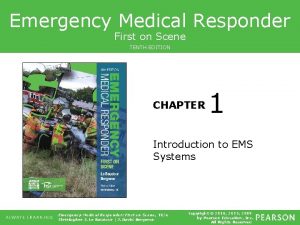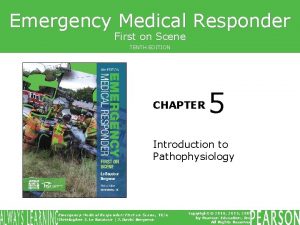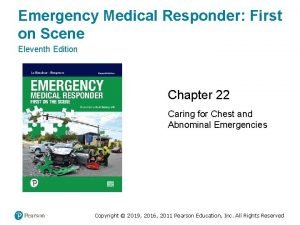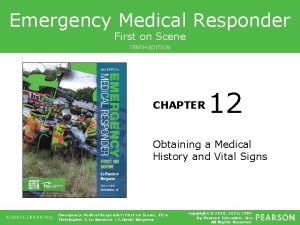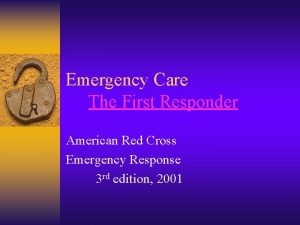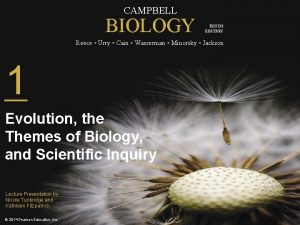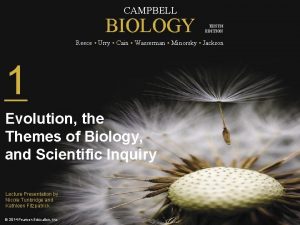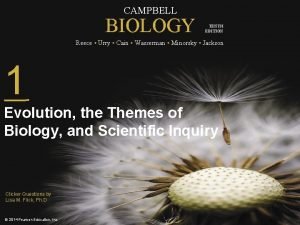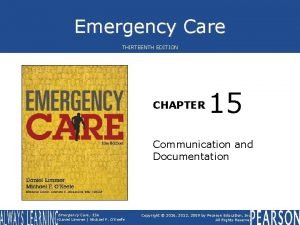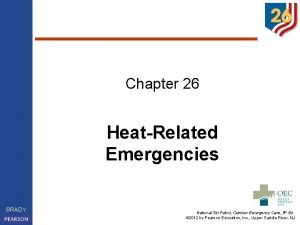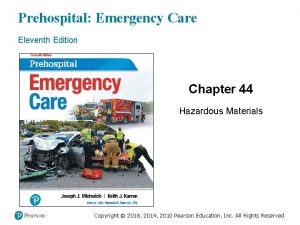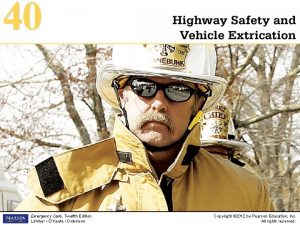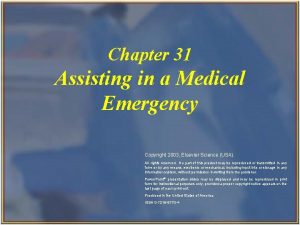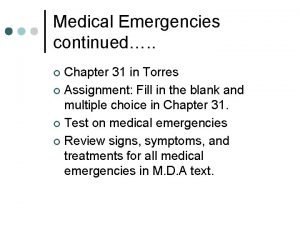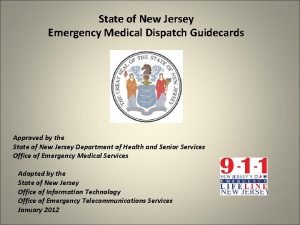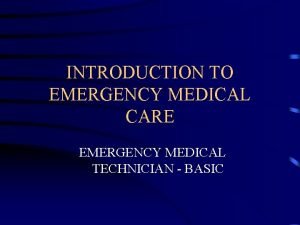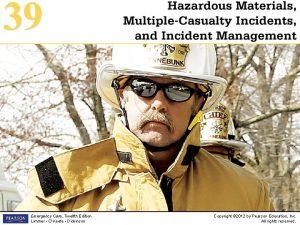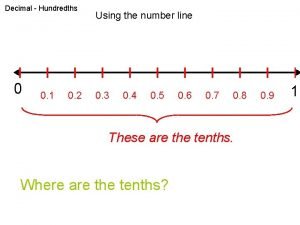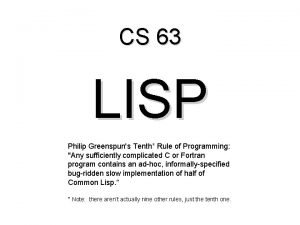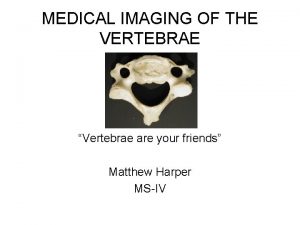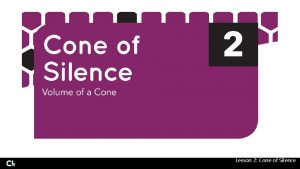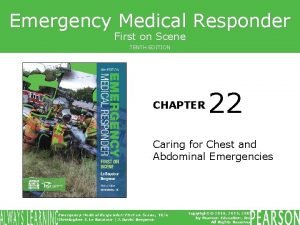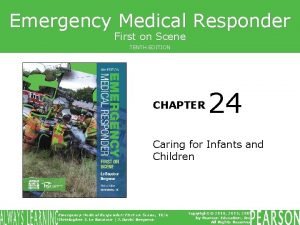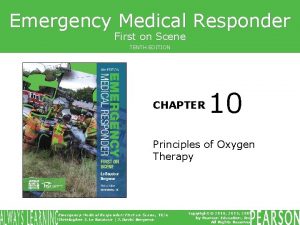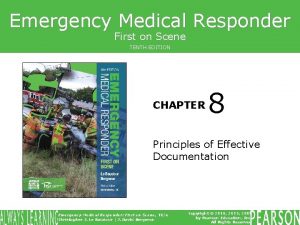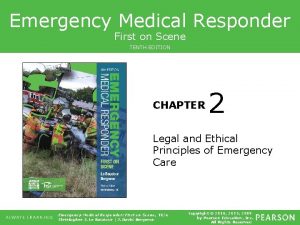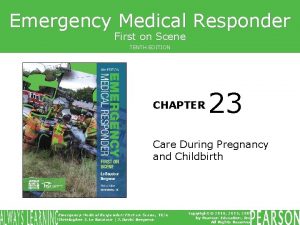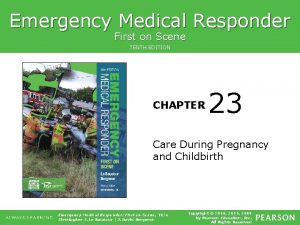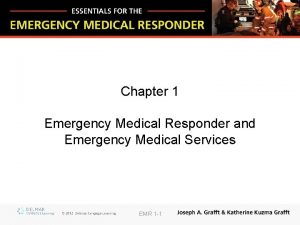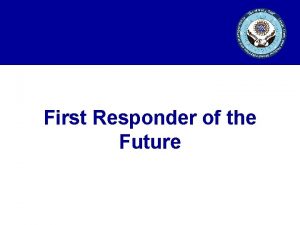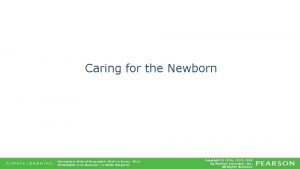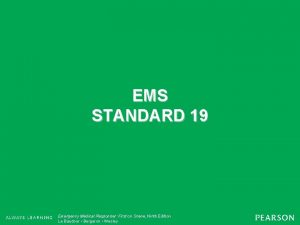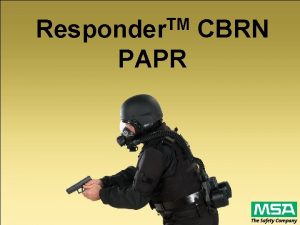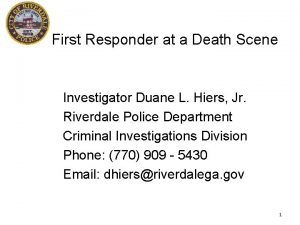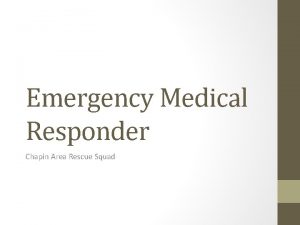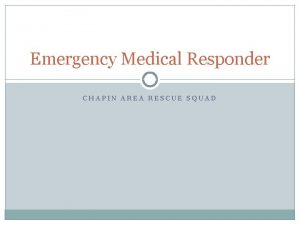Emergency Medical Responder First on Scene TENTH EDITION























































- Slides: 55

Emergency Medical Responder First on Scene TENTH EDITION CHAPTER 19 Recognition and Care of Shock Emergency Medical Responder: First on Scene, 10/e Christopher J. Le Baudour | J. David Bergeron Copyright © 2016, 2011, 2009 by Pearson Education, Inc. All Rights Reserved

Objectives 1. Define the following terms: a. b. c. d. e. f. g. Anaphylactic shock Cardiogenic shock Compensated shock Decompensated shock Hemorrhagic shock Hypoperfusion Hypotension continued on next slide Emergency Medical Responder: First on Scene, 10/e Christopher J. Le Baudour | J. David Bergeron Copyright © 2016, 2011, 2009 by Pearson Education, Inc. All Rights Reserved

Objectives 1. Define the following terms: h. Hypovolemic shock i. Neurogenic shock j. Perfusion k. Psychogenic shock l. Respiratory/metabolic shock m. Septic shock n. Shock continued on next slide Emergency Medical Responder: First on Scene, 10/e Christopher J. Le Baudour | J. David Bergeron Copyright © 2016, 2011, 2009 by Pearson Education, Inc. All Rights Reserved

Objectives 2. Explain the pathophysiology of shock. 3. Describe the four categories of shock. 4. List the seven main types of shock and their causes. 5. Describe the signs and symptoms of shock. continued on next slide Emergency Medical Responder: First on Scene, 10/e Christopher J. Le Baudour | J. David Bergeron Copyright © 2016, 2011, 2009 by Pearson Education, Inc. All Rights Reserved

Objectives 6. Explain the proper care of a patient presenting with signs and symptoms of shock. 7. Demonstrate the proper techniques for caring for a patient at risk for shock. 8. Value the importance of proper body substance isolation (BSI) precautions when caring for a patient with suspected shock. Emergency Medical Responder: First on Scene, 10/e Christopher J. Le Baudour | J. David Bergeron Copyright © 2016, 2011, 2009 by Pearson Education, Inc. All Rights Reserved

Media Directory Slide 11 Shock Animation Emergency Medical Responder: First on Scene, 10/e Christopher J. Le Baudour | J. David Bergeron Copyright © 2016, 2011, 2009 by Pearson Education, Inc. All Rights Reserved

Topics Perfusion and Shock Mechanism of Injury and Shock Emergency Medical Responder: First on Scene, 10/e Christopher J. Le Baudour | J. David Bergeron Copyright © 2016, 2011, 2009 by Pearson Education, Inc. All Rights Reserved

PERFUSION AND SHOCK Emergency Medical Responder: First on Scene, 10/e Christopher J. Le Baudour | J. David Bergeron Copyright © 2016, 2011, 2009 by Pearson Education, Inc. All Rights Reserved

Perfusion and Shock • Perfusion § Adequate supply of well-oxygenated blood and nutrients to all vital organs § Oxygen and carbon dioxide exchange § Nutrients and waste products exchange § Fluid and salt balance maintained between blood and tissues Emergency Medical Responder: First on Scene, 10/e Christopher J. Le Baudour | J. David Bergeron Copyright © 2016, 2011, 2009 by Pearson Education, Inc. All Rights Reserved

Perfusion and Shock • Shock (hypoperfusion) § Failure of body's circulatory system to provide enough oxygenated blood and nutrients to all vital organs § Inadequate oxygen and carbon dioxide exchange § Inadequate nutrient and waste product exchange § Fluid and salt imbalance Emergency Medical Responder: First on Scene, 10/e Christopher J. Le Baudour | J. David Bergeron Copyright © 2016, 2011, 2009 by Pearson Education, Inc. All Rights Reserved

Shock Animation Click on the screenshot to view an animation on the topic of shock. Back to Directory Emergency Medical Responder: First on Scene, 10/e Christopher J. Le Baudour | J. David Bergeron Copyright © 2016, 2011, 2009 by Pearson Education, Inc. All Rights Reserved

Perfusion and Shock • Shock can be life-threatening. • The progression of shock can occur rapidly or over several hours to days. • Care for patients with shock should not be delayed. Emergency Medical Responder: First on Scene, 10/e Christopher J. Le Baudour | J. David Bergeron Copyright © 2016, 2011, 2009 by Pearson Education, Inc. All Rights Reserved

Figure 19. 1 If left untreated, blood loss will lead to shock and eventually death. Emergency Medical Responder: First on Scene, 10/e Christopher J. Le Baudour | J. David Bergeron Copyright © 2016, 2011, 2009 by Pearson Education, Inc. All Rights Reserved

Perfusion and Shock • Shock Categories § Cardiogenic • Cardiogenic (also a type) § Distributive • • Neurogenic Anaphylactic Psychogenic Septic continued on next slide Emergency Medical Responder: First on Scene, 10/e Christopher J. Le Baudour | J. David Bergeron Copyright © 2016, 2011, 2009 by Pearson Education, Inc. All Rights Reserved

Perfusion and Shock • Shock Categories § Hypovolemic • Hemorrhagic § Obstructive § Respiratory/metabolic Emergency Medical Responder: First on Scene, 10/e Christopher J. Le Baudour | J. David Bergeron Copyright © 2016, 2011, 2009 by Pearson Education, Inc. All Rights Reserved

19. 1. 1 Cardiogenic shock, also known as pump failure, occurs when the heart is not able to pump blood efficiently to maintain adequate perfusion. Emergency Medical Responder: First on Scene, 10/e Christopher J. Le Baudour | J. David Bergeron Copyright © 2016, 2011, 2009 by Pearson Education, Inc. All Rights Reserved

Figure 19. 2 Heart attack as a cause of cardiogenic shock: Damaged heart muscle results in reduced force of contractions and reduced cardiac output. Emergency Medical Responder: First on Scene, 10/e Christopher J. Le Baudour | J. David Bergeron Copyright © 2016, 2011, 2009 by Pearson Education, Inc. All Rights Reserved

Perfusion and Shock • Cardiogenic Category § Cardiogenic shock (type) • The heart is unable to pump enough blood at consistent pressure to all vital organs. Emergency Medical Responder: First on Scene, 10/e Christopher J. Le Baudour | J. David Bergeron Copyright © 2016, 2011, 2009 by Pearson Education, Inc. All Rights Reserved

19. 1. 2 Distributive shock is caused by abnormal changes in blood vessel size. This can occur with severe allergic reaction or spinal-cord injury. Emergency Medical Responder: First on Scene, 10/e Christopher J. Le Baudour | J. David Bergeron Copyright © 2016, 2011, 2009 by Pearson Education, Inc. All Rights Reserved

Figure 19. 3 Shock can be caused by an uncontrolled dilation of the blood vessels. Emergency Medical Responder: First on Scene, 10/e Christopher J. Le Baudour | J. David Bergeron Copyright © 2016, 2011, 2009 by Pearson Education, Inc. All Rights Reserved

Perfusion and Shock • Distributive Category § Neurogenic shock • Occurs when spinal cord is damaged and unable to control tone of blood vessels by way of sympathetic nervous system § Anaphylactic shock • Occurs when body experiences severe allergic reaction continued on next slide Emergency Medical Responder: First on Scene, 10/e Christopher J. Le Baudour | J. David Bergeron Copyright © 2016, 2011, 2009 by Pearson Education, Inc. All Rights Reserved

Perfusion and Shock • Distributive Category § Psychogenic shock • Results in a sudden, temporary dilation of blood vessels § Septic shock • Widespread infection of the blood Emergency Medical Responder: First on Scene, 10/e Christopher J. Le Baudour | J. David Bergeron Copyright © 2016, 2011, 2009 by Pearson Education, Inc. All Rights Reserved

19. 1. 3 Hypovolemic shock occurs when there is an inadequate amount of fluid in the body, either blood or other fluids such as water and plasma. Emergency Medical Responder: First on Scene, 10/e Christopher J. Le Baudour | J. David Bergeron Copyright © 2016, 2011, 2009 by Pearson Education, Inc. All Rights Reserved

Figure 19. 4 other fluids. (A) Hemorrhagic hypovolemia: loss of blood. (B) Nonhemorrhagic hypovolemia: loss of plasma and Emergency Medical Responder: First on Scene, 10/e Christopher J. Le Baudour | J. David Bergeron Copyright © 2016, 2011, 2009 by Pearson Education, Inc. All Rights Reserved

Perfusion and Shock • Hypovolemic Category § Hemorrhagic shock • Occurs when body loses significant amount of whole blood from circulatory the system Emergency Medical Responder: First on Scene, 10/e Christopher J. Le Baudour | J. David Bergeron Copyright © 2016, 2011, 2009 by Pearson Education, Inc. All Rights Reserved

19. 1. 4 heart. Obstructive shock occurs when the obstruction of a major vessel causes less blood to be pumped by the Emergency Medical Responder: First on Scene, 10/e Christopher J. Le Baudour | J. David Bergeron Copyright © 2016, 2011, 2009 by Pearson Education, Inc. All Rights Reserved

Figure 19. 5 tamponade. Causes of obstructive shock: (A) pulmonary embolism, (B) tension pneumothorax, (C) pericardial Emergency Medical Responder: First on Scene, 10/e Christopher J. Le Baudour | J. David Bergeron Copyright © 2016, 2011, 2009 by Pearson Education, Inc. All Rights Reserved

Perfusion and Shock • Respiratory/Metabolic § Disruption of oxygen transfer into the cells or cells unable to utilize the available oxygen § Caused by cyanide, carbon monoxide, or iron poisoning Emergency Medical Responder: First on Scene, 10/e Christopher J. Le Baudour | J. David Bergeron Copyright © 2016, 2011, 2009 by Pearson Education, Inc. All Rights Reserved

Perfusion and Shock • The Body's Response During Shock § Compensated stage § Decompensated stage Emergency Medical Responder: First on Scene, 10/e Christopher J. Le Baudour | J. David Bergeron Copyright © 2016, 2011, 2009 by Pearson Education, Inc. All Rights Reserved

Perfusion and Shock • Compensated Shock § Condition in which body is using specific mechanisms to compensate for lack of adequate perfusion Emergency Medical Responder: First on Scene, 10/e Christopher J. Le Baudour | J. David Bergeron Copyright © 2016, 2011, 2009 by Pearson Education, Inc. All Rights Reserved

Perfusion and Shock • Early Signs and Symptoms of Shock § § § § Restlessness Altered mental status Increased heart rate Normal to slight low blood pressure Mildly increased breathing rate Skin that is pale, cool, and moist Sluggish pupils Nausea and vomiting Emergency Medical Responder: First on Scene, 10/e Christopher J. Le Baudour | J. David Bergeron Copyright © 2016, 2011, 2009 by Pearson Education, Inc. All Rights Reserved

19. 2. 1 The patient will experience anxiety and mental status changes. The brain begins to feel the effect of decreased oxygen. continued on next slide Emergency Medical Responder: First on Scene, 10/e Christopher J. Le Baudour | J. David Bergeron Copyright © 2016, 2011, 2009 by Pearson Education, Inc. All Rights Reserved

19. 2. 2 The patient will have cool, pale, sweaty skin and an increased pulse and respirations. Blood is shunted from the skin to the vital areas. Pulse and respirations increase to compensate for shock. continued on next slide Emergency Medical Responder: First on Scene, 10/e Christopher J. Le Baudour | J. David Bergeron Copyright © 2016, 2011, 2009 by Pearson Education, Inc. All Rights Reserved

19. 2. 3 In addition to sweating, the patient may also experience nausea and vomiting as blood is shunted from the intestines to more vital organs. Emergency Medical Responder: First on Scene, 10/e Christopher J. Le Baudour | J. David Bergeron Copyright © 2016, 2011, 2009 by Pearson Education, Inc. All Rights Reserved

Perfusion and Shock • Decompensated Shock § Condition in which body is no longer able to compensate for lack of adequate perfusion Emergency Medical Responder: First on Scene, 10/e Christopher J. Le Baudour | J. David Bergeron Copyright © 2016, 2011, 2009 by Pearson Education, Inc. All Rights Reserved

Perfusion and Shock • Signs and Symptoms § § § § Unresponsiveness Decreasing heart rate Very low blood pressure Slow and shallow respirations Skin that is pale, cool, and moist Dilated, sluggish pupils Respiratory and cardiac arrest can develop Emergency Medical Responder: First on Scene, 10/e Christopher J. Le Baudour | J. David Bergeron Copyright © 2016, 2011, 2009 by Pearson Education, Inc. All Rights Reserved

19. 2. 4 A dropping blood pressure is a late sign of shock. Emergency Medical Responder: First on Scene, 10/e Christopher J. Le Baudour | J. David Bergeron Copyright © 2016, 2011, 2009 by Pearson Education, Inc. All Rights Reserved

Think About It • You respond to an apartment and find a pale 66 -year-old male lying on a sofa. He is weak and dizzy. He states that he has vomited twice and shows you a bucket with a large amount of blood. His pulse is 142, and his blood pressure is 80/50. • What do you suspect? • How will you proceed? Emergency Medical Responder: First on Scene, 10/e Christopher J. Le Baudour | J. David Bergeron Copyright © 2016, 2011, 2009 by Pearson Education, Inc. All Rights Reserved

MECHANISM OF INJURY AND SHOCK Emergency Medical Responder: First on Scene, 10/e Christopher J. Le Baudour | J. David Bergeron Copyright © 2016, 2011, 2009 by Pearson Education, Inc. All Rights Reserved

Mechanism of Injury and Shock • Do not wait for signs and symptoms to develop before caring for shock. • In cases of trauma or injury, examine and consider mechanism of injury. • If patient suffered blunt trauma to head, chest, abdomen, or pelvis, suspect internal bleeding and provide care accordingly. Emergency Medical Responder: First on Scene, 10/e Christopher J. Le Baudour | J. David Bergeron Copyright © 2016, 2011, 2009 by Pearson Education, Inc. All Rights Reserved

Mechanism of Injury and Shock • Caring for Shock § § § § Perform primary assessment. Ensure ABCs are properly supported. Control external bleeding. Administer oxygen per local protocol. Keep patient in supine position. Calm and reassure patient. Maintain normal body temperature. continued on next slide Emergency Medical Responder: First on Scene, 10/e Christopher J. Le Baudour | J. David Bergeron Copyright © 2016, 2011, 2009 by Pearson Education, Inc. All Rights Reserved

Mechanism of Injury and Shock • Caring for Shock § Monitor and support the ABCs. § Do not give patient anything by mouth. § Monitor patient's vital signs. Emergency Medical Responder: First on Scene, 10/e Christopher J. Le Baudour | J. David Bergeron Copyright © 2016, 2011, 2009 by Pearson Education, Inc. All Rights Reserved

Mechanism of Injury and Shock • Fainting (Syncope) § Self-correcting form of mild shock § Examine patient for injury if patient fell. § Keep patient lying down and at rest for several minutes. continued on next slide Emergency Medical Responder: First on Scene, 10/e Christopher J. Le Baudour | J. David Bergeron Copyright © 2016, 2011, 2009 by Pearson Education, Inc. All Rights Reserved

Mechanism of Injury and Shock • Fainting (Syncope) § Always recommend that patient see physician. § Fainting may be pyschogenic or due to more serious conditions such as brain tumor, heart disease, or diabetes. Emergency Medical Responder: First on Scene, 10/e Christopher J. Le Baudour | J. David Bergeron Copyright © 2016, 2011, 2009 by Pearson Education, Inc. All Rights Reserved

Think About It • You respond to a motorcycle collision. You find a 19 -year-old male 50 feet from his sport race bike which is significantly mangled. You find your patient conscious and wearing a helmet, but in only shorts and tank top. He is bleeding profusely. • What are your concerns? • How do you proceed? Emergency Medical Responder: First on Scene, 10/e Christopher J. Le Baudour | J. David Bergeron Copyright © 2016, 2011, 2009 by Pearson Education, Inc. All Rights Reserved

SUMMARY Emergency Medical Responder: First on Scene, 10/e Christopher J. Le Baudour | J. David Bergeron Copyright © 2016, 2011, 2009 by Pearson Education, Inc. All Rights Reserved

Summary • Perfusion § Adequate supply of well-oxygenated blood and removal of waste products from body's tissues, especially vital organs • Shock (hypoperfusion) § Failure of body's circulatory system to provide enough oxygenated blood and nutrients to all vital organs continued on next slide Emergency Medical Responder: First on Scene, 10/e Christopher J. Le Baudour | J. David Bergeron Copyright © 2016, 2011, 2009 by Pearson Education, Inc. All Rights Reserved

Summary • Signs and Symptoms of Shock § § § § Increased pulse Increased breathing rate Restlessness or combativeness Pale, cool, and moist skin Thirst Weakness Nausea and vomiting Loss of responsiveness Emergency Medical Responder: First on Scene, 10/e Christopher J. Le Baudour | J. David Bergeron continued on next slide Copyright © 2016, 2011, 2009 by Pearson Education, Inc. All Rights Reserved

Summary • Types of Shock § § Cardiogenic Hypovolemic Distributive Obstructive • Begin caring for shock if MOI suggests internal injury or bleeding. continued on next slide Emergency Medical Responder: First on Scene, 10/e Christopher J. Le Baudour | J. David Bergeron Copyright © 2016, 2011, 2009 by Pearson Education, Inc. All Rights Reserved

Summary • Do not wait for signs and symptoms to appear before caring for shock. • Care for Shock § Support the ABCs. § Keep patient lying flat. § Control all external bleeding. continued on next slide Emergency Medical Responder: First on Scene, 10/e Christopher J. Le Baudour | J. David Bergeron Copyright © 2016, 2011, 2009 by Pearson Education, Inc. All Rights Reserved

Summary • Care for Shock § Administer oxygen if allowed. § Maintain normal body temperature. § Expedite transport. Emergency Medical Responder: First on Scene, 10/e Christopher J. Le Baudour | J. David Bergeron Copyright © 2016, 2011, 2009 by Pearson Education, Inc. All Rights Reserved

REVIEW QUESTIONS Emergency Medical Responder: First on Scene, 10/e Christopher J. Le Baudour | J. David Bergeron Copyright © 2016, 2011, 2009 by Pearson Education, Inc. All Rights Reserved

Review Questions 1. How would you explain the pathophysiology of shock? 2. How would you describe the four categories of shock? 3. What are the seven main types of shock and their causes? continued on next slide Emergency Medical Responder: First on Scene, 10/e Christopher J. Le Baudour | J. David Bergeron Copyright © 2016, 2011, 2009 by Pearson Education, Inc. All Rights Reserved

Review Questions 4. What are the signs and symptoms of shock? 5. How would you proceed to care of a patient presenting with signs and symptoms of shock? Emergency Medical Responder: First on Scene, 10/e Christopher J. Le Baudour | J. David Bergeron Copyright © 2016, 2011, 2009 by Pearson Education, Inc. All Rights Reserved

Please visit www. bradybooks. com and follow the Resource Central links to access content for this text. Emergency Medical Responder: First on Scene, 10/e Christopher J. Le Baudour | J. David Bergeron Copyright © 2016, 2011, 2009 by Pearson Education, Inc. All Rights Reserved
 Emergency medical responder: first on scene
Emergency medical responder: first on scene Cardiopulmonary
Cardiopulmonary Emergency medical responder first on scene 11th edition
Emergency medical responder first on scene 11th edition Antecubital
Antecubital Red cross emergency medical responder
Red cross emergency medical responder Campbell biology tenth edition
Campbell biology tenth edition Campbell biology tenth edition
Campbell biology tenth edition Campbell biology tenth edition
Campbell biology tenth edition Elementary statistics tenth edition
Elementary statistics tenth edition Digital fundamentals answers
Digital fundamentals answers Corporate finance tenth edition
Corporate finance tenth edition Psychology tenth edition in modules
Psychology tenth edition in modules Introduction to genetic analysis tenth edition
Introduction to genetic analysis tenth edition Corporate finance tenth edition
Corporate finance tenth edition Corporate finance tenth edition
Corporate finance tenth edition Corporate finance tenth edition
Corporate finance tenth edition Corporate finance tenth edition
Corporate finance tenth edition Campbell biology tenth edition
Campbell biology tenth edition The graph shows data from the light colored soil enclosure
The graph shows data from the light colored soil enclosure Clorosplastos
Clorosplastos Biology tenth edition
Biology tenth edition Law enforcement first responder
Law enforcement first responder The standards of prehospital emergency care
The standards of prehospital emergency care Pre-hospital communication
Pre-hospital communication Emergency care 13th edition chapter 1
Emergency care 13th edition chapter 1 Outdoor emergency care 6th edition
Outdoor emergency care 6th edition Prehospital emergency care 11th edition
Prehospital emergency care 11th edition Prehospital emergency care 11th edition study guide
Prehospital emergency care 11th edition study guide Prehospital emergency care 11th edition
Prehospital emergency care 11th edition Prehospital emergency care 11th edition
Prehospital emergency care 11th edition Using mis (10th edition) 10th edition
Using mis (10th edition) 10th edition Using mis (10th edition)
Using mis (10th edition) Introduction to emergency medical care
Introduction to emergency medical care Chapter 31 assisting in a medical emergency
Chapter 31 assisting in a medical emergency Define medical emergency chapter 31
Define medical emergency chapter 31 Medical emergency student lectures
Medical emergency student lectures Emergency medical dispatch guidecards
Emergency medical dispatch guidecards Where's my ride logisticare texas
Where's my ride logisticare texas Introduction to emergency medical care
Introduction to emergency medical care Introduction to emergency medical care
Introduction to emergency medical care Introduction to emergency medical care
Introduction to emergency medical care The tenth man graham greene summary
The tenth man graham greene summary Round 716 to the nearest hundred
Round 716 to the nearest hundred 473 rounded to the nearest ten
473 rounded to the nearest ten 750 rounded to the nearest hundred
750 rounded to the nearest hundred What is the hundredths place
What is the hundredths place Xkcd lisp
Xkcd lisp The tenth tuesday
The tenth tuesday 151 rounded to the nearest hundred
151 rounded to the nearest hundred Tenth rib
Tenth rib Fire appliance access
Fire appliance access Lesson 2 volume of cones
Lesson 2 volume of cones Tenth may dawned bright and clear
Tenth may dawned bright and clear Tenth chapter wired
Tenth chapter wired Injuries first aid
Injuries first aid Chapter 8 emergency care first aid and disasters
Chapter 8 emergency care first aid and disasters
